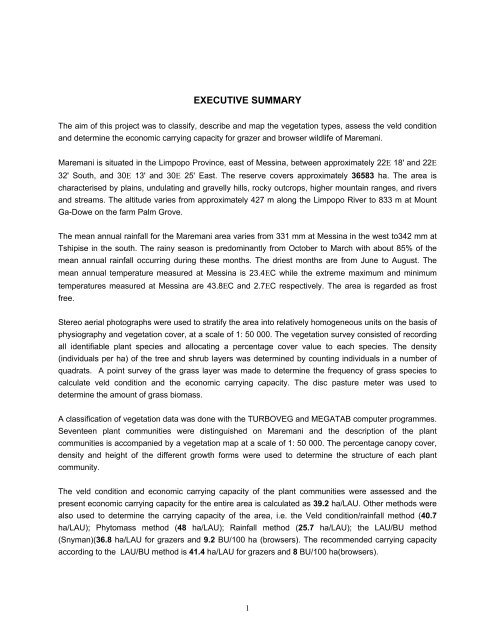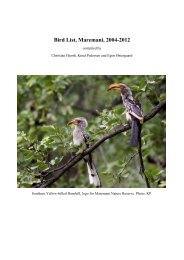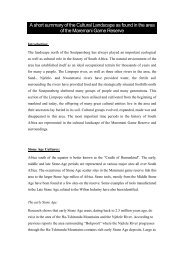the vegetation types and veld condition - Maremani Nature Reserve
the vegetation types and veld condition - Maremani Nature Reserve
the vegetation types and veld condition - Maremani Nature Reserve
You also want an ePaper? Increase the reach of your titles
YUMPU automatically turns print PDFs into web optimized ePapers that Google loves.
EXECUTIVE SUMMARY<br />
The aim of this project was to classify, describe <strong>and</strong> map <strong>the</strong> <strong>vegetation</strong> <strong>types</strong>, assess <strong>the</strong> <strong>veld</strong> <strong>condition</strong><br />
<strong>and</strong> determine <strong>the</strong> economic carrying capacity for grazer <strong>and</strong> browser wildlife of <strong>Maremani</strong>.<br />
<strong>Maremani</strong> is situated in <strong>the</strong> Limpopo Province, east of Messina, between approximately 22Ε 18' <strong>and</strong> 22Ε<br />
32' South, <strong>and</strong> 30Ε 13' <strong>and</strong> 30Ε 25' East. The reserve covers approximately 36583 ha. The area is<br />
characterised by plains, undulating <strong>and</strong> gravelly hills, rocky outcrops, higher mountain ranges, <strong>and</strong> rivers<br />
<strong>and</strong> streams. The altitude varies from approximately 427 m along <strong>the</strong> Limpopo River to 833 m at Mount<br />
Ga-Dowe on <strong>the</strong> farm Palm Grove.<br />
The mean annual rainfall for <strong>the</strong> <strong>Maremani</strong> area varies from 331 mm at Messina in <strong>the</strong> west to342 mm at<br />
Tshipise in <strong>the</strong> south. The rainy season is predominantly from October to March with about 85% of <strong>the</strong><br />
mean annual rainfall occurring during <strong>the</strong>se months. The driest months are from June to August. The<br />
mean annual temperature measured at Messina is 23.4ΕC while <strong>the</strong> extreme maximum <strong>and</strong> minimum<br />
temperatures measured at Messina are 43.8ΕC <strong>and</strong> 2.7ΕC respectively. The area is regarded as frost<br />
free.<br />
Stereo aerial photographs were used to stratify <strong>the</strong> area into relatively homogeneous units on <strong>the</strong> basis of<br />
physiography <strong>and</strong> <strong>vegetation</strong> cover, at a scale of 1: 50 000. The <strong>vegetation</strong> survey consisted of recording<br />
all identifiable plant species <strong>and</strong> allocating a percentage cover value to each species. The density<br />
(individuals per ha) of <strong>the</strong> tree <strong>and</strong> shrub layers was determined by counting individuals in a number of<br />
quadrats. A point survey of <strong>the</strong> grass layer was made to determine <strong>the</strong> frequency of grass species to<br />
calculate <strong>veld</strong> <strong>condition</strong> <strong>and</strong> <strong>the</strong> economic carrying capacity. The disc pasture meter was used to<br />
determine <strong>the</strong> amount of grass biomass.<br />
A classification of <strong>vegetation</strong> data was done with <strong>the</strong> TURBOVEG <strong>and</strong> MEGATAB computer programmes.<br />
Seventeen plant communities were distinguished on <strong>Maremani</strong> <strong>and</strong> <strong>the</strong> description of <strong>the</strong> plant<br />
communities is accompanied by a <strong>vegetation</strong> map at a scale of 1: 50 000. The percentage canopy cover,<br />
density <strong>and</strong> height of <strong>the</strong> different growth forms were used to determine <strong>the</strong> structure of each plant<br />
community.<br />
The <strong>veld</strong> <strong>condition</strong> <strong>and</strong> economic carrying capacity of <strong>the</strong> plant communities were assessed <strong>and</strong> <strong>the</strong><br />
present economic carrying capacity for <strong>the</strong> entire area is calculated as 39.2 ha/LAU. O<strong>the</strong>r methods were<br />
also used to determine <strong>the</strong> carrying capacity of <strong>the</strong> area, i.e. <strong>the</strong> Veld <strong>condition</strong>/rainfall method (40.7<br />
ha/LAU); Phytomass method (48 ha/LAU); Rainfall method (25.7 ha/LAU); <strong>the</strong> LAU/BU method<br />
(Snyman)(36.8 ha/LAU for grazers <strong>and</strong> 9.2 BU/100 ha (browsers). The recommended carrying capacity<br />
according to <strong>the</strong> LAU/BU method is 41.4 ha/LAU for grazers <strong>and</strong> 8 BU/100 ha(browsers).<br />
1




